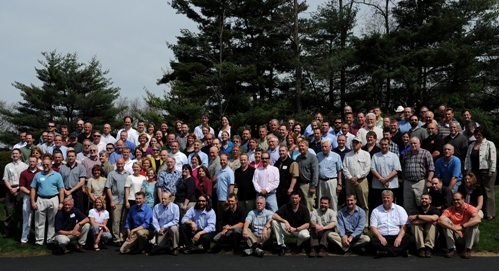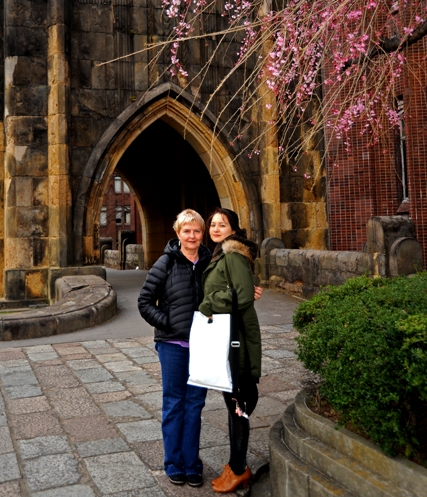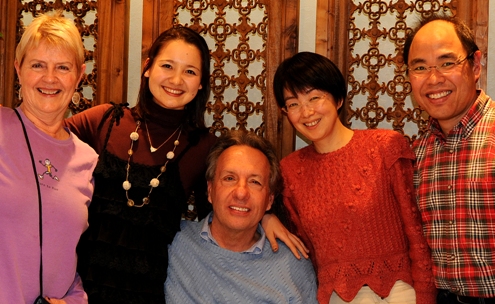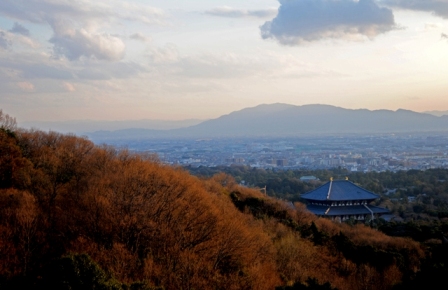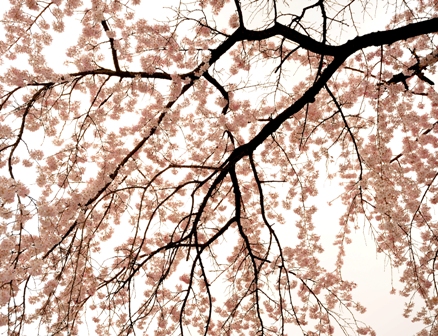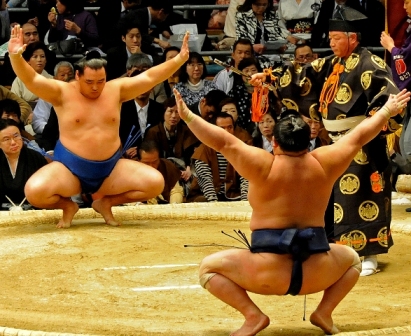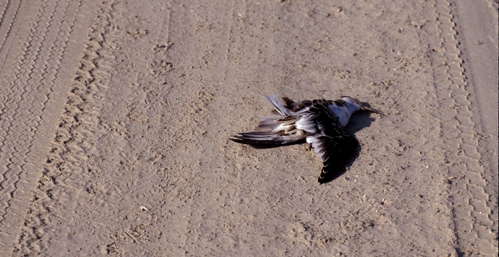
Texas boys and girls joyride their way across our beaches, leaving flattened wildlife and rutted beaches and dunes in their wake. Texas anglers, too sluggish to actually walk to the shore to fish, steer their pick’em trucks to the water’s edge where they can offload their beer and bait. Drive-by birders clamp their scopes to side windows and chase the birds from the comfort of air conditioning. All ignore who gets hurt.
Here’s who.
Black skimmers nest, when able, on the beach at San Luis Pass. They carve out a small depression in the sand where they lay their eggs. They nest colonially, so they are hard to miss.
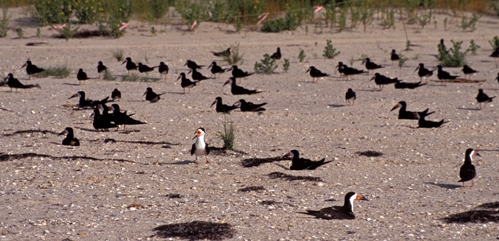
Of course the eggs are difficult to see in the nest itself. These birds nest in exposed areas, and therefore their eggs are patterned much like the sand and shell around them.
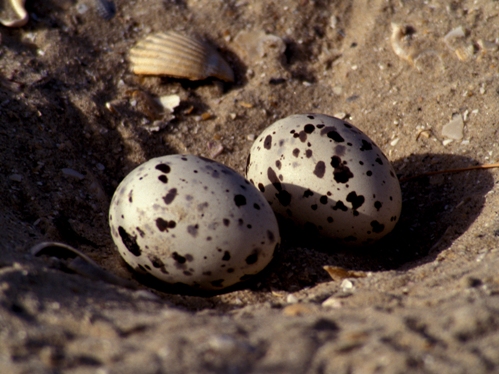
The young skimmers are most vulnerable as hatchlings (i.e., after hatching but before they can fly). Young skimmers are easy prey for raccoons, coyotes, feral cats, and ORVs. Skimmers will hide their young in the shade of any adjacent vegetation to keep them cool and safe.
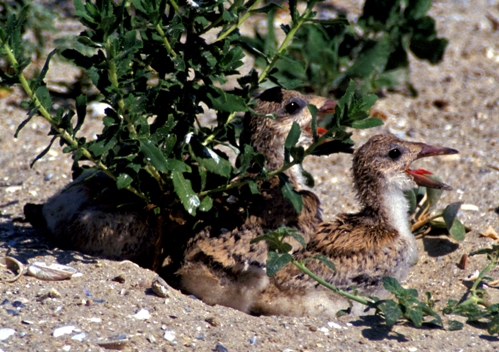
Skimmers are rarely alone in the nesting colonies. They are often joined by gull-billed terns, an uncommon breeder along the upper Texas coast.
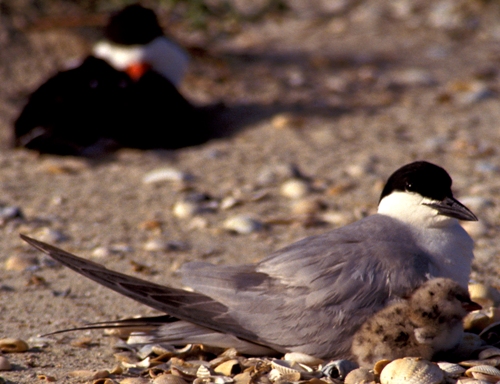
Shorebirds such as the snowy plover, Wilson’s plover, and willet will nest nearby. Snowy plover has only recent begun to recover from a population crash most likely due to increased beach traffic.
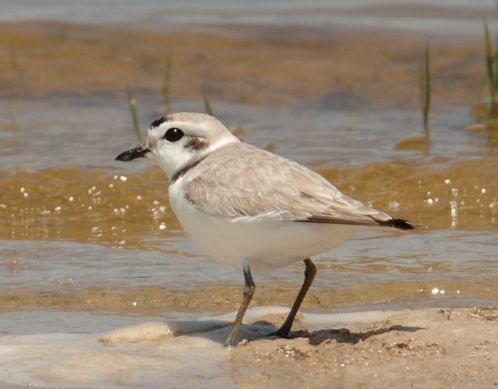
A few of the birds that nest here are unique to the region. The Texas horned lark is but one of numerous subspecies, but with its generous yellow wash about the face and head it may be the most attractive. Horned larks, too, nest here at San Luis Pass flats.
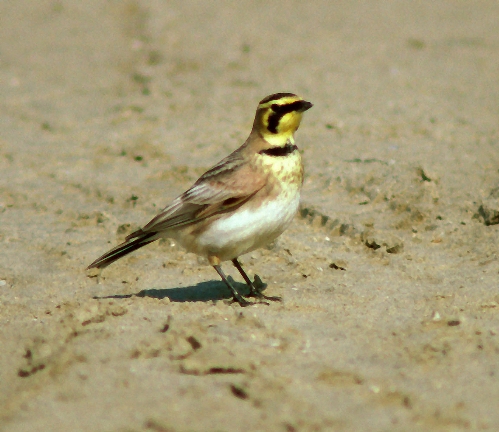
Some, like the piping plover, are threatened. Other wildlife species, such as Kemp’s Ridley sea turtle, are endangered. Yet all depend on San Luis Pass for some portion of their lives.

Many of the San Luis Pass species gather, at times, in immense aggregations. For example, after nesting many of the gulls and terns bring their young to San Luis Pass flats for the remainder of the season. In this way they only have to make short flights between their young and the waters where they feed. Some gather here after nesting far away. For example, the black tern is an inland tern that breeds throughout the Great Plains east through the Great Lakes. In late summer and early fall they stage at San Luis Pass flats, gaining weight and energy stores before making their migratory flight to the coast of northern South America. These staging flocks at San Luis Pass can be dazzling, with as many as 25,000 birds congregated on the sand flats and floating over the waters of San Luis Pass on a single day.
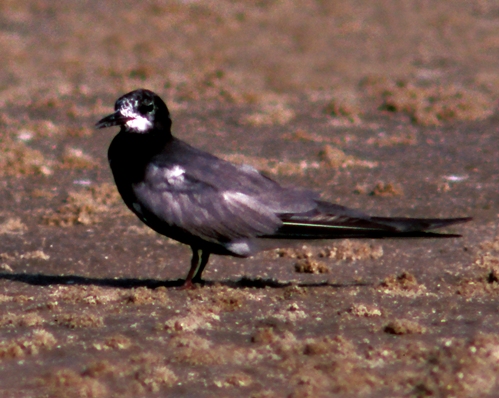
These are but a few of the species that are being decimated by the failure of the local, state, and federal governments to protect them. The laws are in place; the enforcement is absent. Galveston would rather prosecute one local birder who took it on himself to control the feral cat population than to police the area for which Galveston has jurisdiction, authority, and responsibility. Theodore Roosevelt, the greatest American conservation president, said that “surely our people do not understand even yet the rich heritage that is theirs…our people should see to it that they [America’s treasured landscapes] are preserved for their children and their children’s children forever with their majestic beauty unmarred.” San Luis Pass Flats is one of Galveston’s treasured landscapes, and complacency and ignorance are insuring its demise. San Luis Pass is marred. San Luis Pass is disintegrating.
There is nothing new in this saga. I first became involved in trying to protect this area in the 1980s, when the property had been sold to the Dugan family by the Resolution Trust Corporation. The original developer had defaulted during the S&L collapse (remember that fiasco?), and the Dugans had acquired the property at a bargain basement price. They immediately tried to limit vehicular traffic in the region, and the locals squealed. The city capitulated.
Later I became involved in San Luis Pass when the Dugans decided to sell to yet another development company,Centex. The new buyer wanted to restrict vehicular traffic on the beach, and I wanted to get the cars and trucks away from the birds and other wildlife. While some traffic has been eliminated near Point San Luis, the vehicles simply moved to the end of the island and the flats. Then Centex bailed (beginning to see a pattern?), and the property ended up being owned by Macfarlan Capital Partners and their management arm, Terramesa Resort Development.
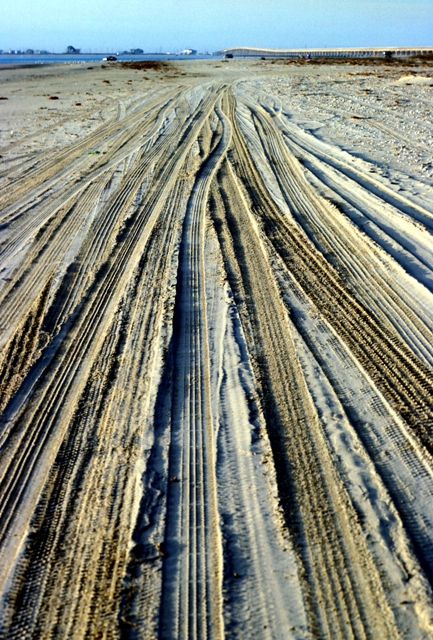
These conservation battles have been fought for decades here. In the 1970s we fought against the George Mitchell development of Eckert’s Bayou, now called Pirates Cove. We argued (without success) that the dynamic nature of this landscape, and its vulnerability to storm surge, made it unsuitable for large-scale housing development. Until Hurricane Ike the building boom on the west end continued, each developer and buyer hoping, against hope, that a storm would not occur on their watch. All balanced on the bubble, praying that they could make their fortunes before time to go (and leave their messes for us to clean up). On 13 September, 2008, the bubble burst.
In the late 1800s heron and egret rookeries in the southeast were decimated by plume hunters. Women of fashion demanded ornate hats decorated with the plumes plucked from birds slaughtered for that reason alone. Roosevelt created the federal wildlife reserve system (wildlife refuges) by an executive order and a simple “I so declare it.” By the end of his presidency Roosevelt had protected acreage equal to about half of Jefferson’s Louisiana Purchase.
What is rarely mentioned in this otherwise rosy story is the opposition that Roosevelt, Pinchot, and others met every step of the way. The exploiters of nature will always fight against those who want nature preserved. Plumers fought restrictions against slaughtering herons and egrets. Market hunters chaffed at the initiation of the nation’s first game laws. Developers today oppose deeper set backs along Galveston’s beaches.
Gifford Pinchot, in The Fight For Conservation, popularized the notion of conservation. Pinchot argued that “conservation means the greatest good to the greatest number for the longest time.” Galveston has failed to heed Roosevelt and Pinchot’s inspired words. Our heritage is being sacrificed to greed, ignorance, and insouciance. Either dramatic steps are taken at this moment to stem this rising tide of destruction, or, in the end, our children and grandchildren will inherit a wasteland.
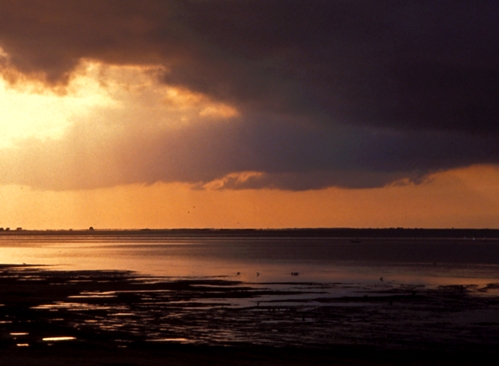
Many of the photos posted above (the skimmers and gull-billed tern, for example) were taken by Bob Behrstock of Naturewide Images Bob is a fantastic nature photographer, a wide-ranging naturalist, and one of my dearest and most loyal friends. Thanks for the photos, Bob (and the birds thank you as well).
Ted Eubanks
17 April 2010


